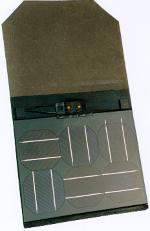Search engine visitors - click here to access entire "$ensible Home" web site
Click here to see a descriptive illustration showing solar cell shingles and panels and a schematic of a typical PV installation.
Dear Jim: With rising electric bills, power outages from storms, global warming, and pollution, I have consider producing my own free electricity at my house with a solar photovoltaic system. What are my options? - Nick R.

A: With recent improvements in solar cell technology and lower costs, installing a photovoltaic (PV) system to generate your own electricity can be a reasonable investment. You generally still stay connected to the utility company.
Homeowners who have installed PV systems say one of the most satisfying experiences is to see their electric meters slow down. On bright sunny days when little electricity is being used, the meter may actually run backward.
A key advantage of a PV system is having electricity during a utility company power outage. Another advantage is PV electricity is "green power" because it causes no pollution or global warming. There is no maintenance required and many systems have a 20-year warranty.
Solar cells are made of silicon, sliced in very thin layers similar to computer chips. When the sun shines on the silicon, it frees electrons that flow through wires attached to the individual cells. Each panel contains many cells, so the electricity output is substantial.
The two types of solar cells used are crystalline or thin film. Crystalline cells are more efficient (less square footage required), but they are more expensive per sq. ft. Overall, your cost is similar. Thin film cells are flexible, so you have more mounting options for unique roof applications.
You have many options for installing a PV system on your home. Once you have the basic system components in place, you can gradually add more solar cell panels as your budget allows. Using inverters, standard 110-volt electricity is available to run your lights, electronics and appliances.
The best and most convenient PV systems use automatic controls and a bank of efficient batteries. If there is a utility power outage, the controls switch entirely to PV power. The electricity will not feed back into the utility wires which could present a hazard to workers repairing the lines.
A typical PV system will have solar cells panels on the roof or the ground in a sunny location. They can be tilted up on the roof to face the sun. To produce the most electricity, there are mounting racks available that automatically follow the sun. They use no electricity, just the sun's heat and gravity to rotate.
A new PV option uses solar cells built directly into shingle panels. They resemble standard shingles and function as the roofing material. If you are building a new house or need a new roof, this option makes a lot of sense.
Instant Download Update Bulletin No. 450 - buyer's guide of 13 PV systems, kits, controls, shingle manufacturers listing solar cell/kit type, selection guide, suggestions on sizing your PV system, overview of photovoltaics (crystalline silicon flat plate systems, thin film systems, concentrators), PV system terms, and illustrations.
Dear Jim: There are several long narrow areas on my ceiling that get discolored with mildew. There are no roof leaks. I painted it with special paint, but the discoloration still comes through. What can I do? - Pete V.
A: The dark areas from mildew are caused by moisture. If you are sure there are no roof leaks, paint the ceiling with several coats of sealer first and then with the finish coat.
If it comes back again, it must still be getting damp somehow. If you have air-conditioning ducts in the attic, condensation may be dripping down. Other than that, the only source of moisture would be a leaky roof.